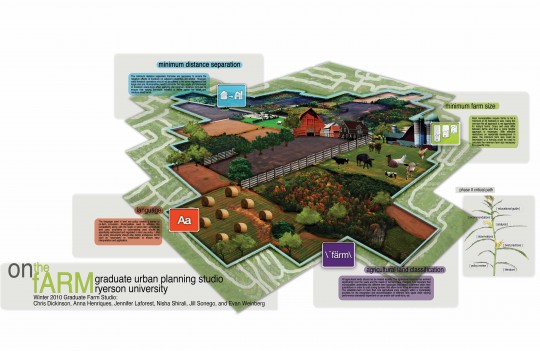Planning for Farm Innovation
Posted: April 21, 2010
Categories: News from Sustain Ontario

Planners take note.
There is definitely a role for planners to play in promoting farm innovation in Ontario’s Greater Golden Horseshoe Region.
That means tackling and addressing issues around land use policies such as agricultural zone classifications, minimum distance separation, minimum farm size and planning policy language that may hinder farm innovation or agricultural viability in the region.
New reports funded by the Metcalf Foundation, and the PELA Institute  entitled Planting the Seeds for Farm Innovation: A Guide to Achieving Flexible Land Use Policy in Ontario’s Greater Golden Horseshoe written by Dr. Nina-Marie Lister, MCIP, RPP of Ryerson University and the Ryerson Planning Students Graduate Farm Studio (Heather Britten, Amanda Chen, Chris Dickinson, Anna Henriques, Sharan Kaur, Jessica Krecklo, Jennifer Laforest, Nisha Shirali, Jill Sonego, Nick Weigeldt, and Evan Weinberg) demonstrates the potential for land use planning policies that encourage farm innovation, which will in turn improve the viability of the farming sector in Ontario.
The geographical areas selected for this study are Niagara Region, Simcoe County and Waterloo Region. These regions were selected as they comprise a rich diversity of agricultural sectors, are close to urban areas, and are facing development pressure. In addition, the report also puts forward international case studies of agricultural land use policies and best practices that may be beneficial when applied to the Ontario context.
The report contains a thorough comparison of municipal Official Plans, and Zoning By-Laws related to agriculture in these regions. It provides an overview that demonstrates how some regions and municipalities are further ahead in encouraging farm innovation and how others may improve their plans/policies to encourage farm innovation.
The overall recommendations in the report are to update outdated zoning by-laws and regulations, and to create more flexible land use policies when dealing with the rapidly evolving farming sector. The issue of planning language also comes to the fore, as the lack of clarity with respect to the language of certain land use policies may hinder the ability of farmers to innovate. This report is a must-read for provincial and municipal planners, as well as anyone interested in the issue of how land use policies impact agriculture viability in Ontario.
Download the final report, Planting the Seeds for Farm Innovation: A Guide to Achieving Flexible Land Use Policy in Ontario’s Greater Golden Horseshoe here.
Download the interim report, Food and Farm Innovation in the Creative Age here.
For more information please contact:
Tammara Soma
Food Systems Planner
